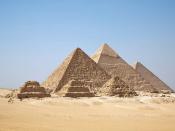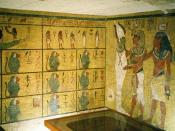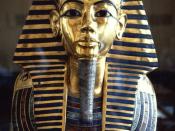I chose the burial mask of Tutankhamun. This mask of Tutankhamun is an example of the highest artistic and technical achievements of the ancient Egyptians in the New Kingdom. Covering the head of the wrapped mummy in its coffin and activated by a magical spell, number 151b from the Book of the Dead, the mask ensured more protection for the king's body. The exact portrayal of the king's facial features achieved here made it possible for his soul to recognize him and return to his mummified body, thus ensuring his resurrection. The head is covered by the royal headdress and the forehead bears the emblems of kingship and protection: the vulture and uraeus, or cobra. The gold sheets used in this wonderful mask are joined together by heating and hammering. The eyes are of obsidian and quartz and the eyebrows and eyelids are inlaid with lapis lazuli. The broad inlaid collar of semiprecious stones and colored glass ends in falcon heads.
The mask is an exact portrayal of the king's facial features and I would say that it could be an icon. Then the cobra and vulture are symbols of the king's kingship and protection. I really do not know why they represent that at but it was part of the culture at that time. One of the possible themes is politics and the social order. Also the second possible theme is stories and histories. I came this by reading an article on a web site to know what the historical representation of the burial mask means during the time that it was created. The art was created in Egypt for King Tutankhamun in 1325 B.C.E. as a burial mask for the death of Tutankhamun. I can not tell you any thing about what was going in the world at...


